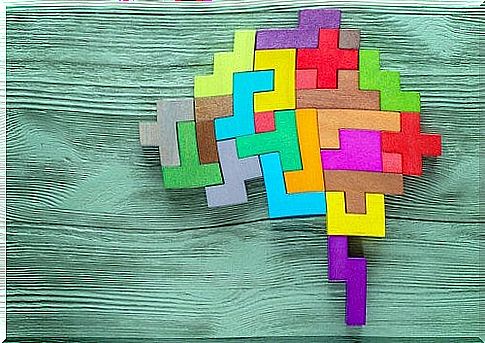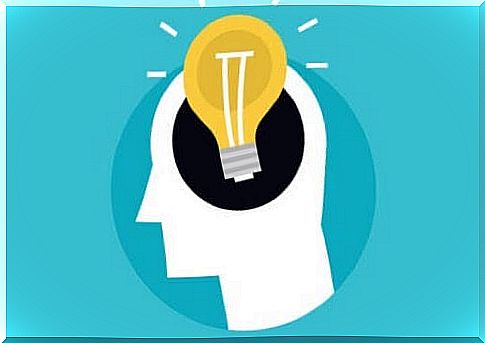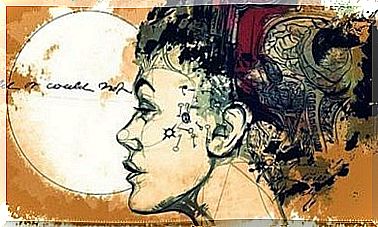Types Of Intelligence: How Many Are There?

Do you know how many types of intelligence exist? Until recently, intelligence was considered an innate and immutable quality. It was believed that the individual was born more or less intelligent and that it was impossible (if not extremely difficult) to change it through learning. It was also thought that the intelligent person excelled in all areas of his life.
It was Howard Gardner who challenged these beliefs through his famous theory of multiple intelligences (1983). According to the latter, there are different types of intelligence, many of which can be developed through emotional intelligence.
Being smart is not the same as being smart in all areas
Gardner defines intelligence as the ability to solve problems or develop products deemed valid for one or more cultures. It does not propose a single intelligence with different characteristics, but rather a set of multiple intelligences that are different and independent between them.
In this sense, he broadens the common concept and states that the genius of a scientist does not necessarily make him as intelligent in every area of his life. To be successful in finance, business, sports, studies, you need to be smart; but each area uses a specific type of intelligence.
It is probable that for a particular discipline one should have one in particular, but none of them is better or less important than the others. To get by in life, therefore, the academic record is relatively important.
Stephen Hawking was neither more nor less intelligent than Don Giovanni or the neighborhood greengrocer, who is a loving person to neighbors and customers and has a beautiful family. Nor was Einstein smarter than Lionel Messi or Bill Gates smarter than Picasso. They are simply different intelligences.
When intelligence is conceived as a skill, it translates into the ability to build the world, to draw new boundaries and to look at life in a different way. Focus on some aspects of the phenomenon observed as a function of the type of intelligence predominant in the individual.

The eight types of intelligence
Human beings can know the world from eight different points of view, since there are eight types of intelligence described by Gardner.
People learn and implement knowledge in different ways. Gardner believes that all humans are capable of extensively developing their intelligence.
These differences show a predilection for a specific field of knowledge and constitute a challenge for the educational system, which structures its curriculum in a universal way based on the belief that all individuals can learn the same subjects in the same way.
Linguistic intelligence
Linguistic intelligence belongs to political leaders, writers, poets and authors. It employs both cerebral hemispheres which contribute to language processing and understanding:
- The left hemisphere elaborates the linguistic meaning of prosody, that is, the cadence of speech, rhythm, tone and emphasis.
- The right hemisphere processes the emotions communicated by the prosody. It therefore implies the ability to understand the order and meaning of words when reading, writing, as well as speaking and listening.
Inside the brain, Broca’s area is responsible for the processing of grammar, that is, the production of sentences with a complex grammatical structure ; Wernicke’s area, on the other hand, allows understanding of language.
Logical-mathematical intelligence
Logico-mathematical intelligence has historically been considered “the only intelligence”. It is based on the ability to solve problems in logic and mathematics.
It is characterized by a clear predominance of the left hemisphere and is the intelligence attributed to scientists, engineers, economists, etc., as it allows deduction, systematization in the construction of hypotheses and their evaluation, information processing and simultaneous contemplation of multiple variables.
The tests that calculate the intelligence quotient (IQ), evaluate the logical-mathematical intelligence associated with linguistics, since the first is non-verbal and develops more on the idea.
Types of intelligence: spatial
Spatial intelligence is based on the ability to think in three dimensions. It is the typical intelligence of artists, mainly sculptors, but also of architects, sailors, engineers, surgeons, decorators, photographers, designers and publicists, among others.
The brain area responsible for the spatial calculation is the right hemisphere. And in the presence of an injury to him, the subject tends to have difficulty in orientation, in recognizing faces or places.
Solving spatial problems is a skill used in navigation, in driving a car to reach an unknown place, in the use of maps, but also in the game of chess and, of course, in the graphic and visual arts and in the employment of the three dimensions.
It allows to create mental images, to represent ideas, consequently to draw their ideational representation. The focus is on the visual details.
Musical intelligence
Musical intelligence allows musicians, singers and dancers, composers, music critics, etc., to express themselves correctly. Through it you can write, create and analyze music ; as well as singing, dancing, listening and playing the instruments.
In the right hemisphere there are some areas related to perception and musical production. In the development of the child, the ability to auditory perception (ear and brain) is present from early childhood and in an innate form. This ability is linked to learning sounds, tones, and instruments.
Types of intelligence: kinesthetic-corporeal
Kinesthetic intelligence is the ability to express oneself through the body and to perform actions that require strength, coordination and balance, speed, flexibility, as well as making repairs or creating with the hands. It is the intelligence of craftsmen, athletes, surgeons, sculptors, actors, models, dancers, etc.
The control of movement and of the body in general is localized in the brain, to be exact in the motor cortex: each hemisphere dominates or controls the movements of the body corresponding to the opposite side.
Beyond gross motor skills, the evolution of specific body movements (fine motor skills) is of great importance in the development of the human species, starting from the general motor coordination capacity up to the resolution of problems that involve a certain ability in handle tools.
It is evident that the body is used differently to solve a problem rather than in sport, to express emotions through dance or to create a sculpture; while in the first case it is combined with logical-mathematical intelligence, in all the others it involves the universe of intuition.

Intrapersonal intelligence
Intrapersonal intelligence allows us to know and understand ourselves better. It makes introspection possible, increases awareness of one’s own identity and access to the universe of emotions, allows one to interpret one’s behavior, to tune into one’s own belief system; in short, it is connected to everything that involves contact with one’s inner world.
The frontal lobes provide us with the analytical and critical share about ourselves, while the prefrontal ones provide us with the moral values that orient us with respect to what is right or wrong.
Intrapersonal intelligence oversees the ability to set goals, to increase awareness of one’s abilities to give them course and to know one’s potential based on the objectives. It involves the ability to reflect on oneself, increasing self-knowledge. In other words, it allows us to understand ourselves better and to work on ourselves.
Basically, this analysis and reflection on oneself is the basis of personal identity (who I am), and it is what allows us to have a place in the world.
Types of intelligence: interpersonal
Interpersonal intelligence is what allows us to understand other people, including working with them or helping them recognize and overcome problems. For this reason, it is often found among excellent salespeople, political and religious leaders, professors, therapists and teachers.
It is the ability to detect moods, personality characteristics, expectations and intentionality in others. It is the ability to create human interactions, to perceive intentions, to read implicit language and paraverbal messages. To act effectively and be empathetic in relationships.
Regarding the neurophysiological aspects, the frontal and prefrontal lobes play an important role in interpersonal knowledge. Far beyond phylogenetics, we human beings integrate systems that involve social interaction, cooperation, solidarity, help, leadership; all elements that create group cohesion and harmony.
Naturalistic intelligence
Naturalistic intelligence concerns the ability to observe and study nature, with the aim of knowing it, classifying it and ordering it. It is typical of biologists and botanists who group species or groups of objects and people by establishing differences and similarities between them.
Gardner stated that this intelligence had its origin in the needs of primitive man to adapt to the environment, as it was necessary for him to recognize the species suitable to feed on the harmful ones, build tools for hunting, adapt to the climate and its changes and find refuge. and protection from dangers.
Naturalists are often skilled in observing, identifying and classifying members of a group or species, but also in creating new types. They have the ability to recognize flora and fauna, although this ability can also be applied to any other field of science and culture; since the characteristics of this intelligence are typical of people who dedicate themselves to research and who systematically apply the scientific method.
Some more or less, we all apply this kind of intelligence when dealing with plants, animals, climate change, etc., but this ability unites the scientific classification. However, naturalistic intelligence, in a later revision by Gardner (1986), was ousted from multiple intelligences, which is why there are currently 8 types.

Being smart means being aware of who we are
It is likely that after reading the description of the different types of intelligence you will have identified with one or more of them. This is completely normal and also useful.
Being aware of the type or types of intelligence possessed makes it possible to recognize one’s limits and abilities, as well as train them.
Being smart isn’t just about being good at math, classifying all animal species, creating a detailed monumental sculpture, or having a great job-hunting resume. In real life, being smart is so much more.









